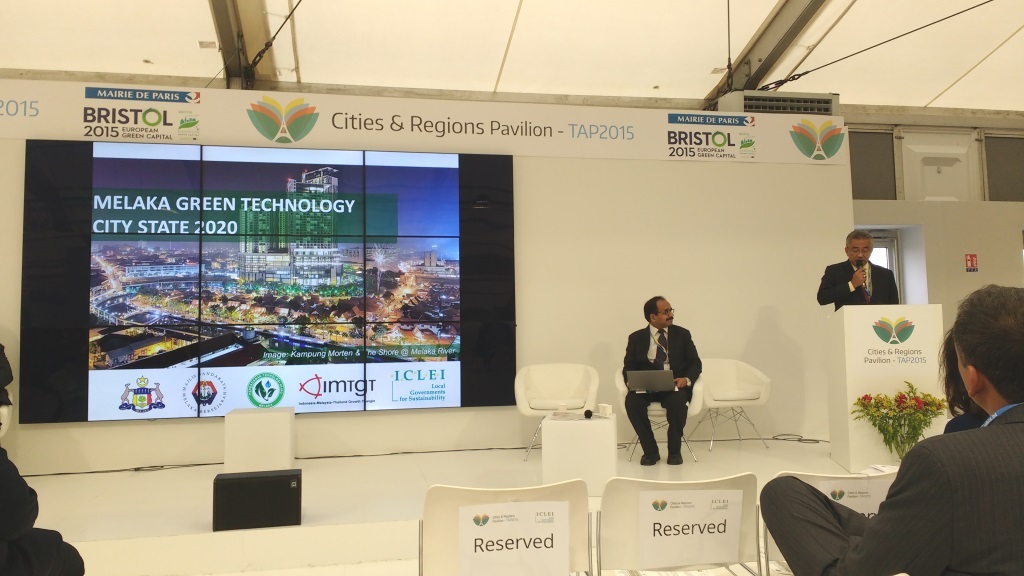#ResilientCities Asia-Pacific Day 3: Financing Urban Resilience
After two days of learning about various perspectives and methodologies in building urban resilience, city leaders and delegates turned to one of the more pivotal issues in the field – that of financing resilience actions – in the penultimate plenary on Day 3 of Resilient Cities Asia-Pacific: 1st Asia-Pacific Forum on Urban Resilience and Adaptation.
In a comprehensive, two-hour discussion, moderated by Ms. Cristina Rumbaitis del Rio, Senior Associate Director at the Rockefeller Foundation, panelists provided a wealth of information and insight on issues such as sources of financing, different methods and modalities of access, and the mechanisms by which funding is delivered to the intended beneficiaries.
‘No shortage of money’
Dr. Peter King, Finance Team Leader for the USAID Adapt Asia-Pacific project, noted that there is actually no shortage of money – only a shortage of ‘financial engineering’ to redirect the available money to local resilience programs.
“We make a mistake quite often thinking only of the [Green Climate Fund] or the Adaptation Fund or other similar external financing,” he said. “There is a lot more out there than the oft-quoted $100 billion that developed countries have pledged [under UNFCCC].”
Cities only have to be more knowledgeable of the available financing opportunities, and better capacitated with respect to the modalities of access. Admittedly, “a lot of finance out there is often difficult or complicated to access,” noted Ms. del Rio.
Mr. Demetrio Innocenti, Monitoring and Evaluation Specialist for the Green Climate Fund – who joined the panel through Skype – described a portfolio of projects that are available to cities, and the mechanisms by which local governments can become accredited to access the GCF. Ms. Sonia Sandhu, Senior Environment Specialist at the Asian Development Bank (ADB), discussed the financing approaches that the ADB is piloting, including a city planning process that channels engagement and capacity to access loans.
“It is time to move away from unilateral approaches,” she said.
One such method, presented by Mr. Peter Gauthier, Investment Officer at the USAID Development Credit Authority (DCA), is the standard loan guarantee provided by DCA. This mechanism, by which the US government guarantees 50% of loans contracted for development projects, allows local governments to access financing which they may otherwise be ineligible to obtain.
“The guarantee can further be used to attract additional financing sources,” said Mr. Gauthier. “We are constantly looking for ways by which the DCA guarantee tool can be used to promote resiliency work in Asia and throughout the world.”
Gaps in project development
On the other hand, cities need to be better-equipped in terms of designing programs for financing. “The funding is out there,” said Mr. Sasank Vemuri, Climate Change Specialist at GIZ-Cities Development Initiatives for Asia (CDIA), “but the problem is there are few sufficiently-developed projects.” CDIA tries to bridge that gap, he says, by conducting ‘pre-feasibility’ studies for local development projects and helping cities structure the same to attract private investment.
“Most of the technical solutions are already out there, too,” said Ms. Lauren Sorkin, Platform Director of 100 Resilient Cities, for cities to learn about and inform their own project development processes. It is a matter of joining collaborative platforms, such as one that 100 Resilient Cities provides, and providing a stronger infrastructure for resilience planning and implementation. One such reform, as suggested by Ms. Sorkin, is the designation of a chief resilience officer in city governments.
These efforts are essential in order to produce more coherent urban resilience projects, which, as Mr. Innocenti of the GCF notes, still require more conceptual precision as far as financing is concerned. “Environmental initiatives tend to get more funding than urban initiatives,” he said. “There is a thin line between what is actually resilience and what are just plain old adaptation methods.”
Further, Mr. Vemuri cautioned about the ‘political tradeoffs’ that tend to influence the project development process. “It is easy to say all of these good things that need to be integrated into projects, but it makes them quite expensive,” he said. “The real challenge is to bring these two aspects [equity and feasibility] together… we have good intentions, but we also need to make things happen on the ground.”
Community involvement
The key, however, is not to exclude the political constituency – far from it – but to involve them deeper and more organically in the process. “Much climate change adaptation has reproduced many of the mistakes that have been made in development initiatives over the last 50 or 60 years,” said Mr. David Dodman, Senior Researcher at the International Institute for Environment and Development. “It has been slow to recognize the particular needs of low-income urban residents… beneficiaries are coming very late to the decision-making process.”
Mr. Dodman advocates for the ‘co-production and co-management’ of solutions, identified by low-income groups and for which they are made accountable. “There is a potential for decentralized funds, managed by organized networks of urban residents – enabling smaller grants to go where they can make a significant difference,” he said.
Mr. Renato Redentor Constantino, CEO of the Institute for Climate and Sustainable Cities, agrees. “We must involve the communities, not just on what they need but also as to how to achieve it successfully,” he said. To this end, civil society plays a huge role in fostering dialogues, providing local communities the necessary information and capacity for developing local resilience actions.
“It is not just important to privilege the poor,” said Mr. Constantino, “it is important to make them participate.”


